Barks Blog
Overstimulation in Cats
by Misty Hampton
The term “overstimulation” is sometimes used among cat professionals. Like any label, it has the potential to be useful in certain contexts. Applied too broadly, it limits understanding. In this article, the author discusses how the term “overstimulation” is applied to cats and proposes a working definition of the term to promote better understanding of cats’ behavior and needs. Overstimulation can be prevented. When we recognize the signs of overstimulation, strategic interventions can lead to better interactions and improved outcomes, for both people and cats.
Starting Point
I was inspired to write this article because the shelter I worked for (a private, limited-admission cat shelter) used the label “overstimulated” to describe cats who exhibited petting-induced aggression, or who reacted to rapid movement by swiping at people and biting. The shelter uses indemnities, which are similar to disclaimers, to ensure that potential adopters are aware of any pre-existing medical or behavioral conditions before taking a cat home.
The “overstimulation” indemnity reads:
Cats can become overstimulated and/or agitated as a result of petting. Overstimulation can result in swats and bites.
Sometimes a cat does not like being petted in a particular location, or sometimes it [sic] does not like too much petting. When cats interact with each other, they spend 15 to 30 seconds in contact with each other, rubbing or grooming. For cats that become overstimulated, we need to pay close attention to where the cat likes and does not like to be pet and only handle them where they are comfortable. Most cats are comfortable with the tops of their heads, backs of their necks, and chins being petted. Most cats do not like having their bellies or feet touched.
Pay attention to warning signs that the cat is becoming agitated. Warning signs include tail swishing, hair on the back rising, skin twitching, eyes dilating, ears shifting out or back, sudden vocalization, and shifting of position. When you see an indication of any of these signs, immediately stop petting.
Provide the cat with lots of environmental enrichment and interactive play to help keep them occupied and entertained. Cats that are under-stimulated are sometimes more likely to show petting-induced aggression. For additional help with this behavior, please contact your adoption counselor or visit our website.
When I first heard about overstimulation, I immediately thought of my cat Linus. I used to call him my “three-stroke kitty” because you could pet him three times before he would bite you. That was back when I first got Linus, before I recognized the importance of consent in interactions with pets.
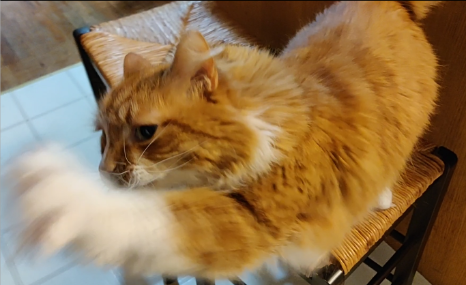
enough petting.
Like so many animal behavior consultants, I got into the field because I wanted to understand my cat’s behavior, and I wanted to help others enjoy better relationships with cats. This article is the result of an eight-year journey of getting to know my cat and learning about overstimulation and petting-induced aggression.
Definitions From Psychology
The terms “overstimulated” and “overstimulation” are sometimes used in reference to cats’ emotional state and resulting behavior. In psychology, overstimulation is “a state of stress and overwhelm a person experiences when there’s too much going on in their environment” (Shafir, n.d.). Sensory overload is thought of most often, but any stimulus has the potential to be overwhelming. For humans, it could be sensory or cognitive, including information overload or an overwhelming amount of communication (Shafir, n.d.). While it is impossible for us to know exactly what another individual is feeling, the idea that, for cats, overstimulation may be similar to what we, as humans, experience gives us a foundation for empathy and understanding.
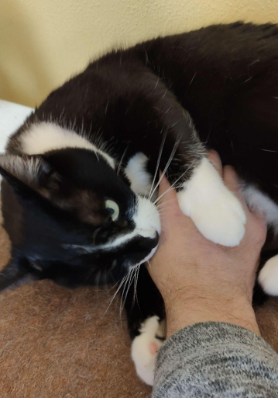
having her belly touched.
Shelter Research
To better understand how the “overstimulation” indemnity was being applied at the shelter, I conducted a census of all the cats that went through the shelter (not including cats still in care) for the year 2023, using the shelter software. Out of the more than 3,000 cats adopted that year, only 18 had the “overstimulated” indemnity. While insufficient for statistical analysis, it is enough to show that overstimulated cats include adults, seniors, and kittens; females and males; short-haired and long-haired cats; and cats of all sorts of colors. This supports the idea that any cat can become “overstimulated.”
Interestingly, the cats who were labeled as “overstimulated” were twice as likely to have medical comorbidities, including dental disease, arthritis, and more. While the limitations of the study preclude generalization, it would be interesting to see if this trend is consistent across several years and in different shelters.
Fifteen of the cats were identified as “overstimulated” as a result of having bitten someone, showing that cats who exhibit aggressive behavior are more likely to be identified. These cats are also at greater risk of behavioral euthanasia—being euthanized for problematic behavior that did not respond to treatment. (Anecdotally, there have only been two cats with behavioral euthanasia outcomes at this shelter over the past five years. Both were “overstimulated” cats.) While this is too small of a number to draw any meaningful conclusions, it is intriguing and invites further study. A colleague in Nebraska works with a shelter where overstimulated cats are more likely to be placed as barn cats.
Because the data come from a census, we can see that the median length of stay (LOS) was longer for cats with the “overstimulation” indemnity in 2023. (The median was used instead of the mean because the data is strongly skewed and includes numerous outliers.)
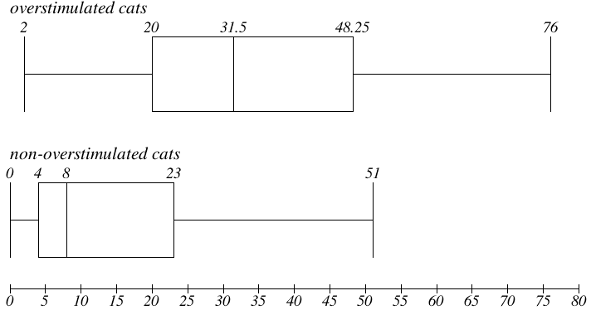
Survey Results
A survey was created to better understand how the word “overstimulation” is used among cat professionals. The survey asked, “In your own words, define ‘overstimulation.’” The question was presented to three Facebook groups: the IAABC Member Forum, the PPG All About Cats group, and the Fear Free Veterinary & Pet Professional Community. Thirty-five people responded to the survey, including 17 veterinary professionals (one with a specialty in behavior) and 18 behavior or other cat professionals (shelter staff, cat sitters, and groomers). As this was a voluntary response sample, not a random sample, the results may not generalize to the overall population of cat professionals. Still, it’s a good starting point, considering that voluntary response samples often capture the strongest opinions.
Responses varied from “I never use the term” to detailed, operationalized definitions. Here are some examples:
One veterinary professional defined overstimulation as “when there is too much sensory input or too much emotional arousal.”
Another said overstimulation is “too much stimuli that put an animal over threshold, leading to either fight or flight reaction. Flight may include shutting down as well.”
One cat sitter said, “Overstimulation happens when the amount of sensory inputs exceeds the cat’s ability to process and cope with them.”
Cat behavior consultant Chris Aytug (CCBC, FFCP) defined overstimulation as “a heightened emotional state driven by a single or multiple triggers that may lead to fear-based or aggressive behavior.”
Finally, one shelter behavior professional said, “The observable expression of overstimulation will vary between species and individuals … and will differ from baseline behavior.”
The key ideas or phrases used most often included:
- Sensory overload/too much stimuli
- Fear, anxiety, and stress (FAS)
- Reaction to touch/excessive petting or handling
- Over threshold
- Aggression
- Arousal
- Triggers/stressors
- Reactive/escalating behavior
Interviews
I conducted a series of interviews with cat behavior and veterinary professionals for more in-depth discussion.
I asked each of them, “Do you use the term ‘overstimulation’ for cats? If you use the term, what does it mean?”
Jennifer Van de Kieft (CAFTP, PNCC, FFCP) responded, “I don’t use this term often since it could refer to lots of different things. I typically think of a cat getting aroused from too much petting or handling, but I think it can also refer to cats who become aroused easily from triggers such as visitors. I think it can also mean cats who have tons of energy and exhibit play aggression.”
Beth Brown (CCBC, CDBC, CSAT, CCUI, CPDT-KSA, FFCP) said, “Yes and no … I will use the term because it seems to resonate with owners. … With other professionals, I tend not to use it because it’s a label…” and we don’t all agree on what it means.
One cat behavior consultant wrote, “It’s usually used to refer to petting a cat too much.” But it can be “any excess of stimuli that pushes an individual over their anxiety threshold and causes them to react by … attacking, or running away and hiding.”
Another cat professional said, “Usually, it is used to mean if you pet the cat too long, they will bite you. But it can also mean layering stressors on top of underlying anxiety. … When the cat says ‘enough’ and acts out aggressively, that’s overstimulation.”
Katenna Jones (ScM, ACAAB, CCBC, CDBC, FFCT), wrote, “I use it in the context of how ‘aroused’ or ‘agitated’ a cat becomes in response to petting, an environment, another animal or person, play/excitement, etc. Basically, in response to any changes or factors in their life.”
Dr. Kat Pankratz (DVM, DACVB) said, “I use ‘overstimulation’ when describing the potential motivation for certain behaviors but not necessarily as a diagnosis.”
Dr. Lore Haug (DVM, MS, DACVB, CABC) said, “For me, the term is not about the cat but the situation the cat has been put into, with an arousal level that the cat hasn’t been prepared to handle.”
Dr. Sally J Foote (DVM) said, “I tend to avoid the term because it’s so general. What does it really mean in the context of the situation? … I prefer to say high stimulation from x, resulting in or shifting to y.”
I found that the term “overstimulation” is applied to two different states:
- becoming overwhelmed = negative emotional state
- becoming overexcited = positive emotional state
The term “overstimulation” is sometimes used to refer to when a cat has high energy and is doing parkour off the furniture—often called “zoomies”—or is exhibiting play aggression. Both of these examples involve the cat being in a positive emotional state. To keep the definition more consistent with human psychology, I will use “overstimulation” to mean the cat is overwhelmed, in a negative emotional state.
It is possible that a stimulus that is in excess of the individual’s ability to process can quickly cross over from being enjoyable to being overwhelming. Context is needed to understand what triggered the behavior that we identify as overstimulation.
What Causes Overstimulation?
Along with defining overstimulation, we discussed potential triggers. A cat’s experience consists of social and emotional elements, not just sensory perception. As a result, there is a wide range of things that can be overstimulating to cats, much like overstimulation in humans. The following graphic summarizes the things interviewees mentioned.
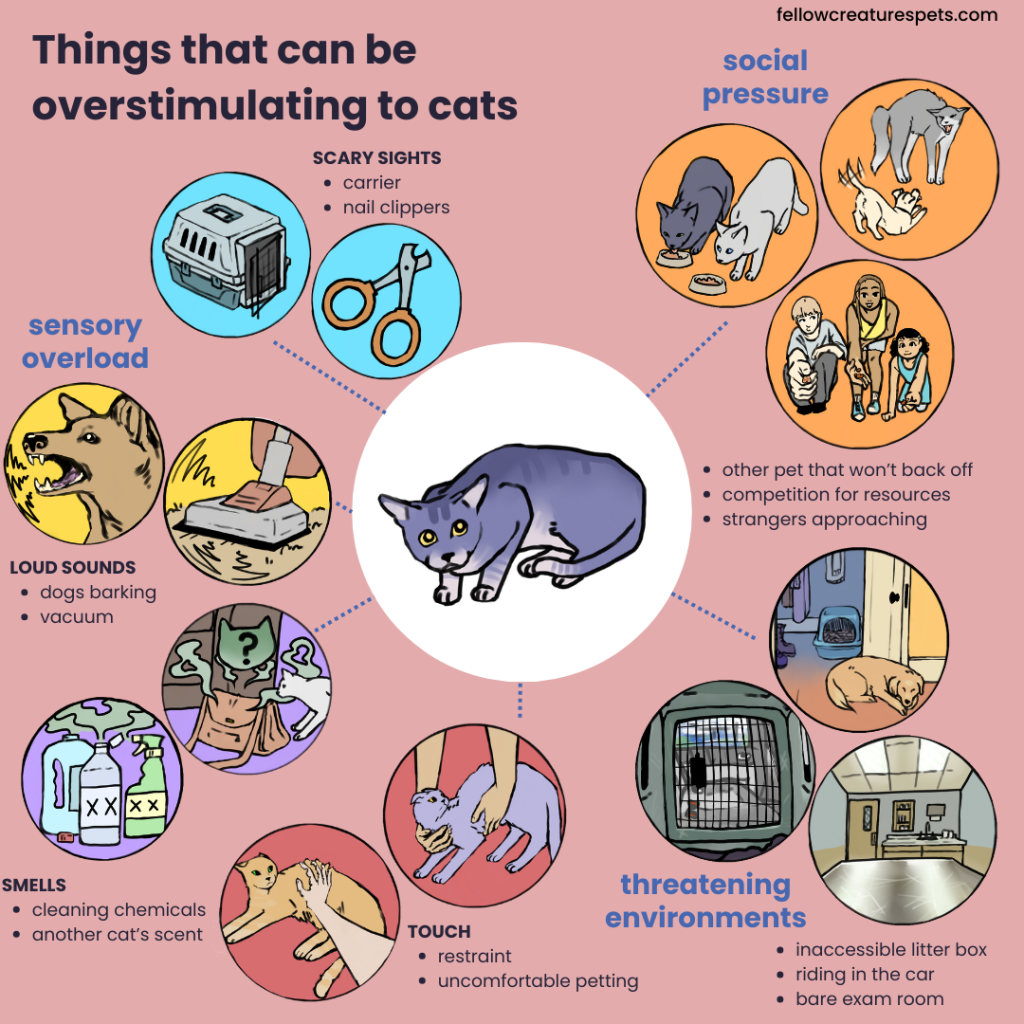
I asked the veterinary professionals, “Are there any medical conditions that you suspect may be related to overstimulation that we should watch for?”
The top suggestions were:
- Inflammation and pain, such as osteoarthritis
- Gut health
- Dental health
- Neurological disease, such as feline hyperesthesia
Jessey Scheip (LVT, VTS, KPA-CTP, FFCP) said, “For a lot of cats with behavior problems, if there aren’t obvious environmental issues causing the problem, I suspect pain or gut issues.”
Dr. Lore Haug said, “It’s so difficult to assess pain in cats, especially in the contexts that we have to assess it. I don’t think we have enough awareness of the ways that cats show discomfort. … [W]e’re not looking for it and we’re not addressing it.”
One disorder that may be related to overstimulation in cats is hyperesthesia. Hyperesthesia is an extreme sensitivity of the cat’s skin usually along the back, especially at the base of the tail (Cornell University, 2023). Feline hyperesthesia is not well understood. It could be a compulsive disorder, but it’s important to rule out any underlying medical problems.
In an article for the Cornell Feline Health Center, Dr. Emma Davies, associate clinical professor of neurology (BVSc, MSc), said, “The most important thing in cats with hyperesthesia is making sure that there is nothing causing the hyperesthesia that we can identify and treat. Cats can have intervertebral disc extrusions and many other disorders that can result in hyperesthesia” (cited in Cornell University, 2023).
Dr. Christine Calder (DVM, DACVB) said, “We actually think that a lot of these cats have intervertebral disc disease. … So they have back pain and that’s why they do it. … Hyperesthesia is one of those conditions where I’ll say ‘We need to start with some pain medication and see what kind of result we get with that.’ … A pain trial is both therapeutic and diagnostic and it’s cheaper than an MRI” (Calder, 2023).
Overstimulation can indicate:
- High FAS
- Pain/medical problem:
- Arthritis
- Hyperesthesia
- Dental disease
- GI issues
I propose a definition of overstimulation as follows:
Overstimulation is when an individual is overwhelmed by stress. (It could be caused by pain, sensory overload, social pressure, or whatever the cat is experiencing internally.) Cats exhibit different responses, depending on the context. They may react with aggression or shut down. One of the most common examples is reacting to excessive touch with aggression.
I included the word “excessive” here to emphasize that overstimulation is not the cat’s fault. The cat is not somehow defective. The cat’s behavior is a normal reaction, considering they are overwhelmed, possibly in pain. The problem is when humans try to handle the cat, unaware that the cat is experiencing overstimulation.
Which Cats Does It Apply To?
Once we had a working definition, I asked all the interviewees, “Can any cat become overstimulated?”
Katenna Jones said, “I think different cats respond differently to various situations. Some cats can be more sensitive to arousal, whereas others are more tolerant or resilient. … Any cat can become overstimulated, in theory, but some cats take a lot to be overstimulated whereas others can become overstimulated even with minimal ‘input.’”
Jessey Scheip said, “I’m sure any cat can become overstimulated, but for a normal neurotypical cat, the likelihood of getting there is pretty low.” Cats who get overstimulated “tend to be easily triggered in general. They are more sensitive to everything.”
Dr. Kat Pankratz said, “Some cats may feel overstimulated more easily or at lower thresholds of stimuli compared to other cats. … I believe any cat could become overstimulated if the environmental triggers presented themselves as such.”
Dr. Lore Haug said, “[C]ats can get overwhelmed from being put in a situation. In a broad sense, it could happen with any cat. For specific cats, there may be a physiological or genetic component that gives them that low threshold.”
One cat behavior consultant said, “Personality and life experiences also play roles in this. Some cats can quickly become neurotic and hypervigilant while others have much higher thresholds for overstimulation.”
Dr. Sally J. Foote said, “There is the potential for any cat to get that sensory overload. … Every animal will have their threshold per source. … That threshold determines tolerance. It’s a combination of their genetics and early development, and life experiences and physical attributes and health.”
Beth Brown said, “Cats that get aroused easily are just like any other cat. We have to look at the situation, starting at the bottom of the hierarchy.” We need to start with health first, then look at the environment. “Does the environment need modification so they aren’t aroused as easily?” She reminds, “Every animal is a study of one.”
Recognizing Overstimulation
Next, I asked, “What does overstimulation look like?”
The consensus is it depends on the individual cat and the context. “Every cat has their own signals,” Beth Adelman (MS) says.
Cats become overstimulated when they are overwhelmed by stressors. Since cats are small animals, they are both predator and prey. When they encounter a threat, their first instinct is usually to flee (a “flight” response). If the threat continues or increases, the cat may become overstimulated.
Early warning signs look like a “fidget” response. When the threat is inescapable, as is often the case in a shelter or veterinary clinic, most cats tend to respond in one of two ways: by shutting down (a “freeze” response, which may develop into learned helplessness) or by escalating to aggression (a “fight” response).
Cats who exhibit a fight reaction when they become overstimulated get the most attention. The indemnity at the beginning of the article is focused on petting-induced aggression. It makes sense, because these cats are the ones who are most likely to bite people. However, cats who exhibit a freeze reaction are also experiencing high levels of stress, and chronic stress is known to have negative impacts on health. For cats, chronic stress can lead to urination outside the litter box, change in appetite, vomiting, diarrhea, overgrooming, pica (eating inedible items), withdrawal, and increased susceptibility to illness, in addition to aggression (Amat et al., 2015).
In the home environment, cats are typically able to flee in response to a threat. When a person insists on handling them, the cat will give warning signs such as a lashing tail, twitching skin, and vocalizing. If the person doesn’t notice or ignores these warnings, then the cat might resort to aggression. It is a well-known principle that behavior that gets reinforced (with the cat’s desired consequence) gets repeated. If people heed the cat’s warning signs, the cat will use them more often. Conversely, if warnings are ignored, the cat will escalate to aggression more quickly in the future. This is why petting-induced aggression can really seem “out of nowhere” to cat owners.
The following graphic summarizes some of the most common warning signs that indicate that a cat is becoming overstimulated, and whether they are likely to exhibit a freeze or fight reaction.
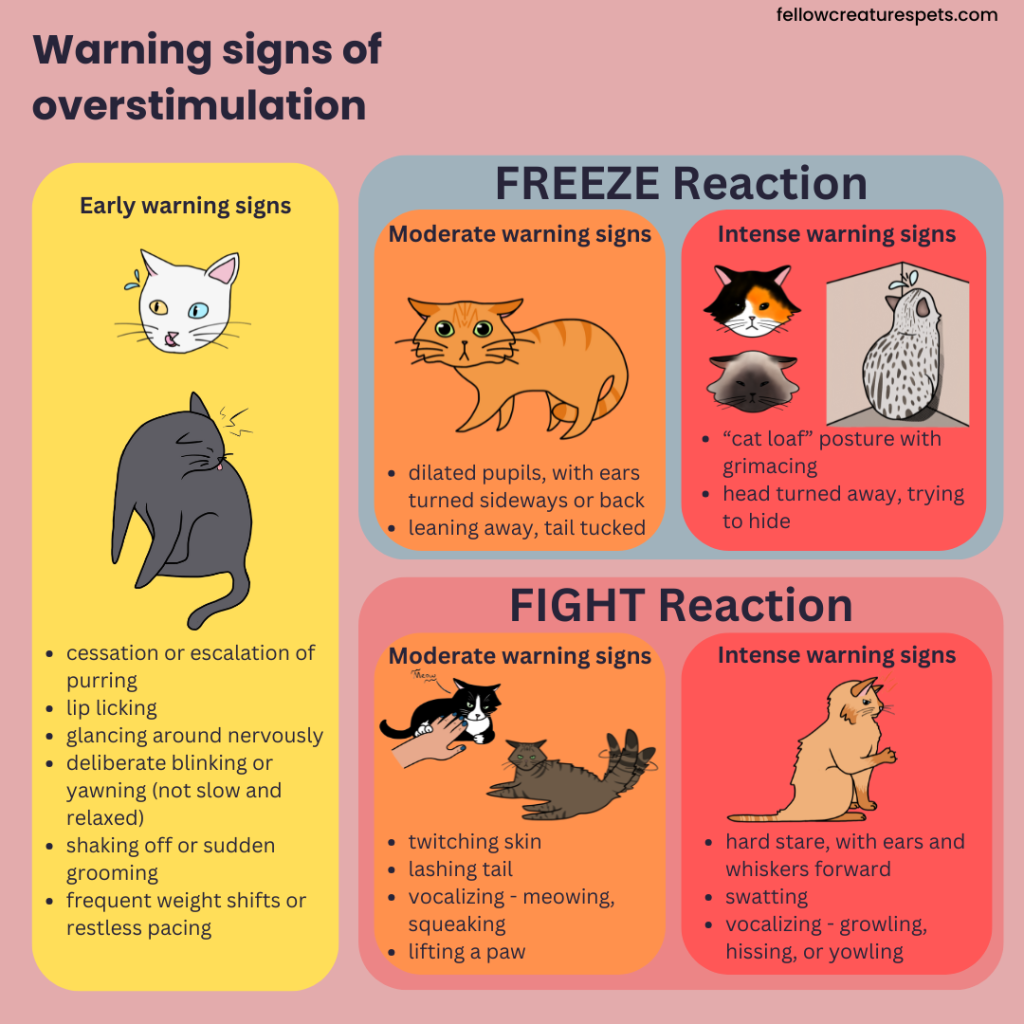
Here is a video with some examples.
An individual cat’s response is shaped by their personality (genetic predispositions) and learning history, including early socialization. Each cat will have a different level of tolerance for different stressors, depending on the context. If the cat has become sensitized to a particular stimulus, they will have a narrower yellow and orange band and escalate to red quickly. I liken it to the gas gauge on some cars that slowly goes down from full to half, and quickly drops from half full to empty.
“Overstimulation” as a Label
I asked the interviewees, “In what ways (if any) do you find the label useful?”
One cat behavior consultant said, “I find it useful when communicating to cat caregivers because it’s a state of mind that most people can relate to. Most of us have been in situations where we became overstimulated and just wanted to run away and find a quiet place to relax.”
Katenna Jones wrote, “[I]t can help clients understand that their cat is in an emotional state and their body/brain is simply responding (as opposed to the common misconception that the cat is choosing to be a jerk). Owners who understand and appreciate their cat as one who tends toward becoming overstimulated can then be prepared for potential issues, respond with patience and empathy, and support their cat through events.”
Allison Hunter-Frederick (CCBC), wrote, “By labeling a cat as ‘overstimulated,’ we’re more likely to recognize that we need [to] limit how much we handle this particular cat. We’re also more likely to focus on finding positive outlets for this cat’s energy needs, such as by playing more often with them and taking them on outings.”
I then asked, “In what ways (if any) do you find the label detrimental?”
Allison Hunter-Frederick wrote, “Unfortunately, the label can also cause us to misdiagnose the reasons for a cat’s aggression. Perhaps the cat is in pain or has matted fur. It can also limit our view of what the cat needs. We might think the cat just needs to be petted less, and miss the fact that the cat isn’t receiving enough enrichment or that it needs a calmer, quieter, and more structured environment.”
Katenna Jones wrote, “A cat may be labeled as ‘easily overstimulated’ and in some cases any ‘unwanted’ behaviors they display may be simply subsequently attributed to that label without ruling out other potential factors.”
Beth Adelman said, “I actually don’t use the term. I’m concerned about pathologizing normal behaviors.” She explained, “I think a lot of what we call ‘overstimulation’ is the cat is excited and we don’t know how to respond. Cats getting excited is normal.” In regard to petting-induced aggression, she said that, often, people have inappropriate expectations. “Less contact is actually more normal for cats. [I]t’s the person who is being inconsiderate.”
One shelter leader said, “[A]ny indemnity slows down a cat’s adoption. They do, however, guide us in working with the cat to hopefully avoid bites and to help them find placement in the best home for them. … Our [behavior] team and our adoption counselors do a great job assessing the cats and getting the information to the adopters so that we can find the right home.”
She shared two stories. I have replaced the cats’ names with the names of my own cats, in case anyone knows them specifically:
Linus bit 3 times in the shelter. He did not like his things moved in his kennel and would get over aroused with too much petting. He is now in a home living with another cat who he adores and is doing great. He has a big home with lots of room and the two boys play a lot and sleep cuddled together.
Abigail did not do well in a kennel. She was swatty and did not like a lot of hands-on touch. She moved to an office – a quiet location and consistent schedule – and made a lot of progress. She was adopted into a quiet single-person home.
My Key Takeaways From the Interviews
Overstimulation is more than just petting-induced aggression.
Overstimulation is not a diagnosis. It’s a response to overwhelming stress. If a cat is easily overstimulated, we need to look deeper to find the underlying cause(s).
Addressing Overstimulation
When we recognize that a cat is experiencing overstimulation, we can look for what’s causing it. Once we identify the issue, we can address any medical problems and modify the environment, to reduce stress. We can set appropriate expectations and adjust the way we interact with the cat, to enjoy a better relationship with them.
Any cat can become overstimulated. However, some cats are more sensitive and are, therefore, more easily overstimulated. By keeping a record of the cat’s behavior in different contexts (Fear Free calls it an Emotional Medical Record), we can identify cats who are more easily overstimulated and recognize their early warning signs.
The website Choosing Therapy offers some recommendations to help people cope with feeling overstimulated: identifying triggers, gradual desensitization, finding a calm environment to relax, mindfulness, managing stress with regular self-care, physical activity, and social support (Shafir, n.d.). Essentially, they are talking about building resilience. Resilience is defined as the ability to adapt to challenging life experiences (APA, n.d.).
Behavior Vets created the Resilience Rainbow to show ways to cultivate resilience. It includes seven domains: Decompression, Safety & Security, Completing the Stress Cycle, Mental & Physical Well-Being, Predictability, Social Support, and Agency. Their recent article gives examples for dogs, but the model is not species-specific (Bhambree and Murphy, 2023). The table below shows how those techniques could translate to cats.
| Technique | Examples |
| Identify triggers | touch, loud noises, other animals, unfamiliar people |
| Consult with a veterinary professional | check for underlying medical issues that may be causing pain (such as hyperesthesia, osteoarthritis, dental pain, GI issues); determine if anti-anxiety medication is appropriate |
| Arrange the environment to minimize stress, avoid triggers | reduce lighting, play soft music in the background, speak softly, avoid using cleaners with strong fragrances, set up easy access to resources and hiding spaces |
| Offer choice and provide predictable interactions | let the cat initiate petting, don’t force the issue; pay attention to the cat’s body language and learn how to interact with them appropriately; maintain a consistent schedule |
| Provide something else for the cat to focus on | bird feeder outside the window, cat TV, interactive play, catnip or cat grass, puzzle feeders, other enrichment |
| Give the cat an outlet for physical activity | interactive play, catio access |
| Teach relaxation techniques | teach the cat to retreat to a sanctuary room or hiding space, or relax on a mat |
| Provide social support | if the cat has a best friend (human or another pet), let them hang out together |
| Use desensitization & counterconditioning if the trigger is unavoidable | gradual exposure to a trigger in a context where it is not overwhelming, stay below threshold, avoid flooding |
For cats who exhibit extreme overstimulation, it’s important to work with a veterinarian or veterinary behaviorist. In some cases, medication may be appropriate. An article from the Journal of Feline Medicine and Surgery says, “Many cats that suffer from anxiety, fear, compulsive behaviour or cognitive decline do not have normal baseline behaviours. For example, many of these cats do not sleep sufficiently, are highly reactive to benign stimuli, are easily overstimulated by the environment, and have reduced appetite and abnormal responses. Psychoactive medications can help to restore normal patterns by balancing levels of neurotransmitters, enhancing neuronal signals and promoting gene translation in the brain. In turn, this can, for example, reduce arousal, anxiety and/or reactivity, and improve learning, the sleep–wake cycle and appetite” (Denenberg and Dubé, 2018).
Prevention
The interviewees shared how we can interact with cats more appropriately, to prevent them from feeling overstimulated.
Jennifer Van de Kieft said, “The cats that can tolerate a lot of petting are the exception. What people see on social media gives us the wrong expectations. It’s hard for people to understand. They don’t believe it until they actually do it, but if you respect the cat’s body language and stop petting them so much, they will seek out more interaction.”
Beth Adelman said, “The more that you respect your cat saying stop, the more they will seek out petting. Let the cat initiate petting. … I also teach clients to use a verbal predictor cue, and to pet in a consistent manner.” She instructs, “Pay attention and you’ll learn what your cat’s warning sign is. If you can’t tell, pet your cat three times and stop. If they don’t move away, do it again.”
Dr. Lore Haug reminded us that we often unintentionally reinforce undesired behavior. This may sometimes be the case with overstimulation. If a cat becomes overstimulated and their response has been reinforced by escape or avoidance (negative reinforcement) or they get attention—even if you’re yelling at them (positive punishment)—they can become sensitized to that stimulus, meaning their threshold is reduced and their behavior intensified.
Dr. Kat Pankratz wrote, “Instead of focusing on ‘stopping the behavior,’ safer approaches would be to try to adjust the environment to prevent the inciting triggers of the unwanted behaviors and/or think about what you can empower the cat to do instead (i.e., come to you, go to a different room) to make the interaction as much of a ‘win-win’ situation as possible.”
As dog trainer and animal behaviorist Chirag Patel (BSc (Hons), CPDT-KA, DipCABT) says, “Listen to your dog’s whisper, so he doesn’t have to shout.” This applies equally to cats.
Finally, one cat professional said, “We need to understand that overstimulation happens from layered-on stressors. We’re the ones that are ultimately responsible for adding on stress. If we can recognize that a cat has a low level of ongoing anxiety, we can address it.”
Closing Thoughts
The term “overstimulation” is a label for a cat’s emotional experience. It is not a diagnosis and should not be permanent. The cat is feeling overwhelmed. When we identify a cat as “overstimulated,” it’s important to describe the behavior and look at the context so we can address it appropriately.
Although any cat can become overstimulated, some cats tend to get overstimulated more easily, due to a combination of their genetics and their learning history. It is also possible that the cat is in pain.
Dr. Kat Pankratz advised, “In general, if there is a newly developed behavior, it is strongly encouraged to pursue a veterinary evaluation to explore the potential underlying medical condition for treatment or to rule out this potential contributing cause,” especially for middle aged or older cats.
Dr. Lore Haug said, “This is an opportunity to remind people that when we use a label, we need to operationally define it so that we all know what we’re talking about.”
Dr. Sally Foote said, “The more descriptive my language is, the more we can understand and apply appropriate treatment, or at least know what to expect.”
Epilogue
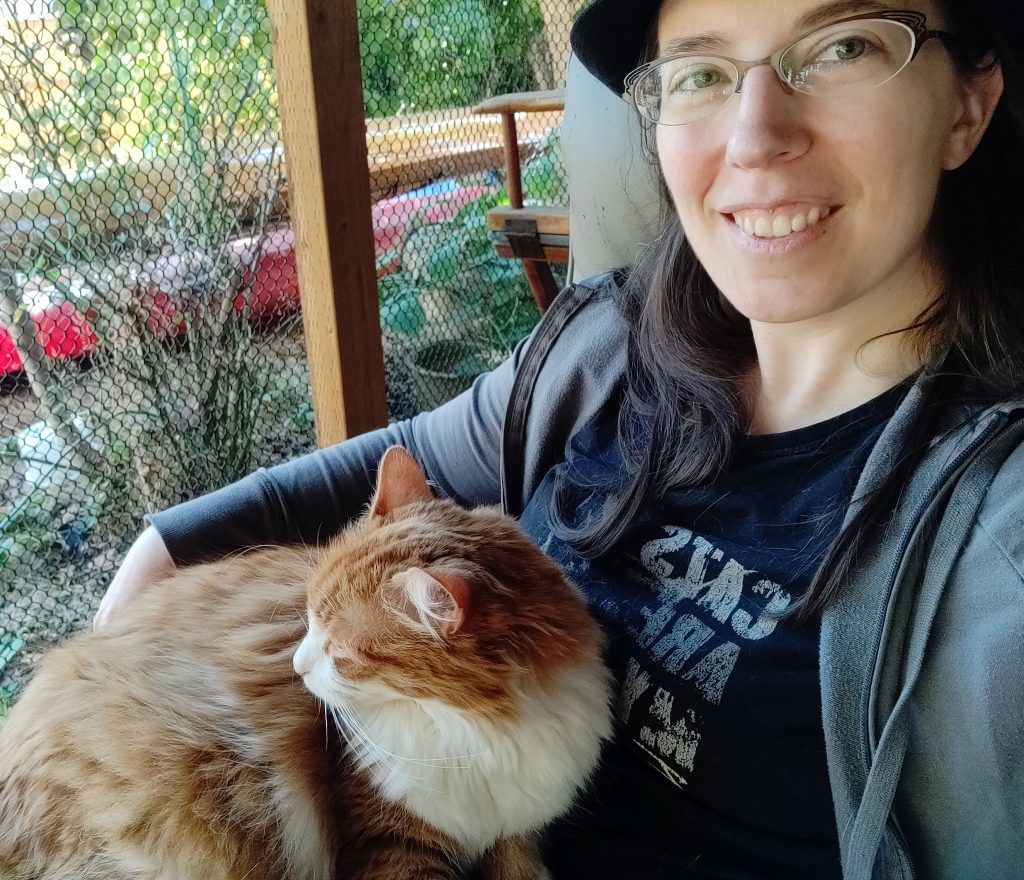
Once I became aware of overstimulation in cats, I had a better understanding of what Linus was experiencing. I learned how to ask for consent when petting, and to pet in a way he prefers. I paid attention to his body language and learned his warning signs so I could stop petting at the first sign of trouble. I taught my friends how to interact with Linus safely, using a considerate approach.
We have a wonderful veterinary team that we work with now. All of our cats get annual checkups where they look for any medical issues. Linus has had multiple dental surgeries, which helped alleviate pain.
Now, Linus seeks attention more often. I present my hand to invite him to be pet. I pause every few seconds, to see if he will initiate more. I try to stop petting before he shows any signs of overstimulation. He often sits on my lap, and he doesn’t always want to be touched. It takes a lot of self-control on my part, but I refrain from petting him non-stop because I want our relationship to be built on respect and trust.
Acknowledgements
Special thanks to the following individuals who contributed to the definition of overstimulation presented in this article: Chris Aytug (CCBC, FFCP); Beth Brown (CCBC, CDBC, CSAT, CCUI, CPDT-KSA, FFCP); Dr. Sally J Foote (DVM); Dr. Lore Haug (DVM, MS, DACVB, CABC); Allison Hunter-Frederick (CCBC); Katenna Jones (ScM, ACAAB, CCBC, CDBC, FFCT); Tom Kirby (UW-AAB, LSHC-S); Jessey Scheip (LVT, VTS, KPA-CTP, FFCP); Dr. Kat Pankratz (DVM, DACVB); Beth Pasek (Elite FFCP); and Jennifer Van de Kieft (CAFTP, PNCC, FFCP).
References
Amat, M., Camps, T., & Manteca, X. (2015). Stress in owned cats: Behavioural changes and welfare implications. Journal of Feline Medicine and Surgery, 18(8), 577–586. https://doi.org/10.1177/1098612×15590867
American Psychological Association. (n.d.). Resilience. Retrieved March 14, 2023, from https://www.apa.org/topics/resilience
Bhambree, B. & Murphy, K. (2023). A framework for behavior modification and training plans to help build and maintain resilience: The Resilience Rainbow. The IAABC Foundation Journal, 26. Retrieved March 14, 2023, from https://journal.iaabcfoundation.org/the-resilience-rainbow/
Calder, C. (2023, November 18). Compulsive Behavior in Cats [Webinar with Q&A]. 3rd Annual Virtual Conference: International Association of Animal Behavior Consultants (IAABC) Foundation.
Cornell University College of Veterinary Medicine. (2023, June 21). Hyperesthesia syndrome. Retrieved March 12, 2023, from https://www.vet.cornell.edu/departments-centers-and-institutes/cornell-feline-health-center/health-information/feline-health-topics/hyperesthesia-syndrome
Denenberg, S. & Dubé, M.B. (2018). Tools for managing feline problem behaviours: Psychoactive medications. Journal of Feline Medicine and Surgery, 20(11):1034-1045. doi:10.1177/1098612X18806760
Shafir, A. H. (n.d.). Overstimulation: What it is & how to cope. Choosing Therapy. Retrieved March 12, 2023, from https://www.choosingtherapy.com/overstimulated/
Misty Hampton (CCBC, FFCP) is a cat trainer and behavior consultant and owner of Fellow Creatures Pet Consulting. She started teaching at age 12. For 13 years, she was an instructor for a home-schooling community. Since 2001, she has been a math and science tutor. Now, she is a life coach for teens and young adults as well. She also runs a birding club for Lake Oswego Parks & Recreation.
Nature and animals have always been in Misty’s life, but it wasn’t until she adopted cats as an adult that she first became interested in studying cat behavior. She worked at a local cat shelter for two years. Then, she spent a year working at a freshwater aquarium warehouse, where she was inspired to start breeding angelfish. Her passion is helping people better understand misunderstood animals. She shares her life with her husband Jesse and their five cats: Linus, Jasper, Abigail, Pearl, and Piper.

